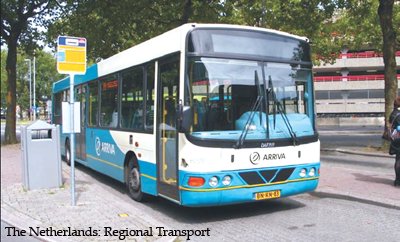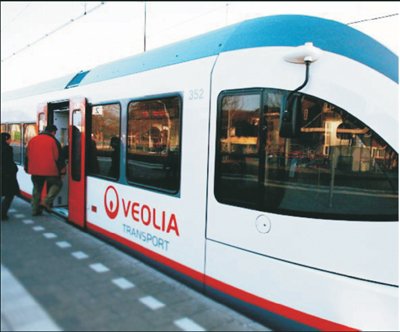For the safety of the driver and the passengers, the driver can send emergency messages. Besides automated vehicle location, in future the board computer will enable passengers to obtain customised and up-to-the-minute information even via mobile applications.
 To improve this situation, public transport organisations need effective tools to measure the real-time situation of their fleets and be able to control, correct, analyse and improve their operations. Sophisticated infrastructure will be needed in which public transport has its own tracks on highly congested roads where traffic lights can be influenced by the bus in order to optimise the punctuality of PT services.
To improve this situation, public transport organisations need effective tools to measure the real-time situation of their fleets and be able to control, correct, analyse and improve their operations. Sophisticated infrastructure will be needed in which public transport has its own tracks on highly congested roads where traffic lights can be influenced by the bus in order to optimise the punctuality of PT services.
To accomplish this mission, ITS systems with sophisticated on-board ICT systems are essential. However, since public transport is, in most cases, financed by taxes, it has to demonstrate the efficiency of its use of the money invested and the effectiveness of the implemented solutions.
To keep the cost of ownership low, these ITS systems will have to be integrated into the AFC and RTPI infrastructure. Efficient ICT-assisted PT solutions that combine the wide range of functionalities will have to be flexible and open so they can be readily adaptable to rapidly evolving needs and technologies. They have to be able to connect and interact with applications and sub-systems from specialised vendors for parts of the overall solution. In order to make the system cost effective and efficient, standards for data exchange and interfacing will be crucial.
Therefore, MobiGuider, an end-to-end mobile software platform designed as a fully open system, integrates AFC, ITS and RTPI functionality in a flexible Service Oriented Architecture (SOA). While MobiGuider_ITS is the Intelligent Transport System module that manages vehicle tracking and tracing, driver guidance, itinerary information and dispatching requirements, MobiGuider_AFC deals with all mobile Automated Fare Collection front-end and back-end issues. MobiGuider_RTPI module, on the other hand, incorporates all the collecting, interpreting, preparing and presenting of passenger information for display and other external systems.
Counting the passengers will assist the efficient deployment of the available vehicles. More comfort will be given to passenger by introducing contactless tickets and cards, using validators to display the balance on the card, load the card or/and purchase event tickets.
The integration of all AFC, ITS and RTPI functionality in one common platform has important inherent advantages such as flexibility in exchanging data among applications; convenience with the same look and feel in all of the graphic user interfaces; consistency in all communications to users; efficiency with common data and communication resources; and, reduced total cost of ownership ? management and maintenance ? with shared equipment, software and ICT infrastructure.
An example of the benefits of an integrated solution is the use of AFC validators as check-in and check-out equipment for counting the actual number of passengers on the bus. This is a typical ITS requirement for tuning service frequency to improve the travellers? comfort level. For the same purpose, the RTPI system extracts from the ITS database all of the real-time-information that is useful for the passenger. The optimum situation, if only for reducing the space they take on the vehicles, is that these systems run on the same on-board computer and use the same network architecture and transmission channels for real-time data communication between the vehicle and the back-office services.
Incidents reported by the drivers are entered into the system, and corrective actions are immediately taken by changing the short-term planning, monitoring and managing obstructions and interchanges, calling in reinforcement trips, and communicating all these activities to both the drivers and the passengers.
 The call for clean nature demands eco-driving assistance in Public Transport. Through a standard CANbus interface, modern buses feed the on-board computer information regarding fuel consumption, use of the brakes, the clutch, the accelerator pedal position, speed and acceleration and engine data. Analysis of these data represented in reports interprets the driving behaviour and skills of the driver objectively and accurately. This behaviour can be improved significantly by presenting this information to the driver and by specific training. The ultimate goals here are to reduce pollution and, equally important, to improve the comfort and safety of the passengers.
The call for clean nature demands eco-driving assistance in Public Transport. Through a standard CANbus interface, modern buses feed the on-board computer information regarding fuel consumption, use of the brakes, the clutch, the accelerator pedal position, speed and acceleration and engine data. Analysis of these data represented in reports interprets the driving behaviour and skills of the driver objectively and accurately. This behaviour can be improved significantly by presenting this information to the driver and by specific training. The ultimate goals here are to reduce pollution and, equally important, to improve the comfort and safety of the passengers.
Another important ITS function is emergency management which is activated manually by pressing an alarm button or automatically by abrupt movements of the bus (for example, in the event of an accident). This immediately, yet discretely, opens a communication channel (audio/video) with the traffic control centre, highlights the vehicle on a map, and triggers surveillance devices (CCTV) and software to bookmark the event. These tools discourage vandalism and make public transport more secure and safe. Counting the number of passengers on a bus is another new requirement to assist the planning of additional or less capacity and to ensure safe and comfortable journeys.
Prodata Mobility Systems has installed such future-proof ?MobiGuider? solutions in The Netherlands in Amsterdam, Eindhoven, Maastricht and elsewhere, with a total of over 2,700 buses and trains. Recently, Prodata Mobility Systems won the De Lijn ReTiBo contract in Belgium where its mobile solution will become the motor powering De Lijn?s efficient and demand-led supply.
The system is prepared to deal in future with more sophisticated applications like detour management, eco-drive, surveillance and dynamic traffic light control.
 TrafficInfraTech Magazine Linking People Places & Progress
TrafficInfraTech Magazine Linking People Places & Progress

